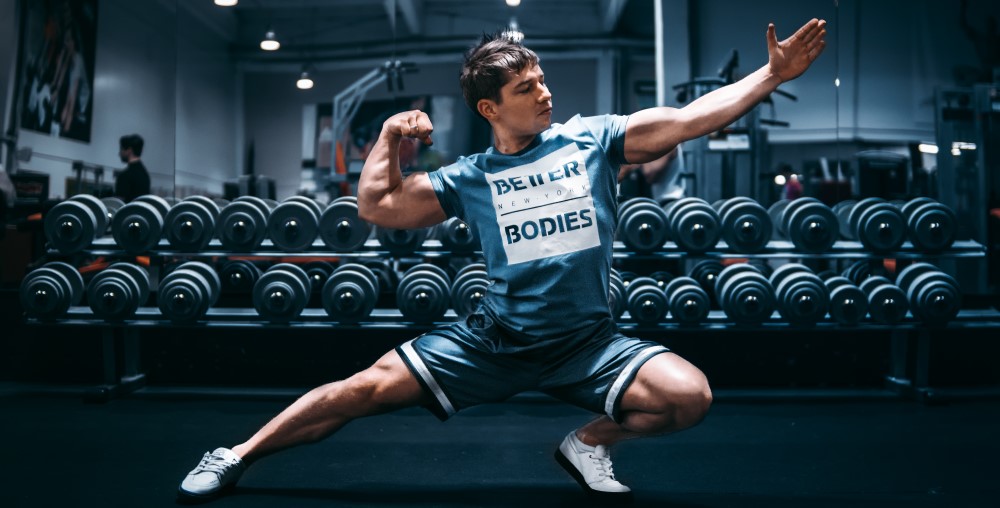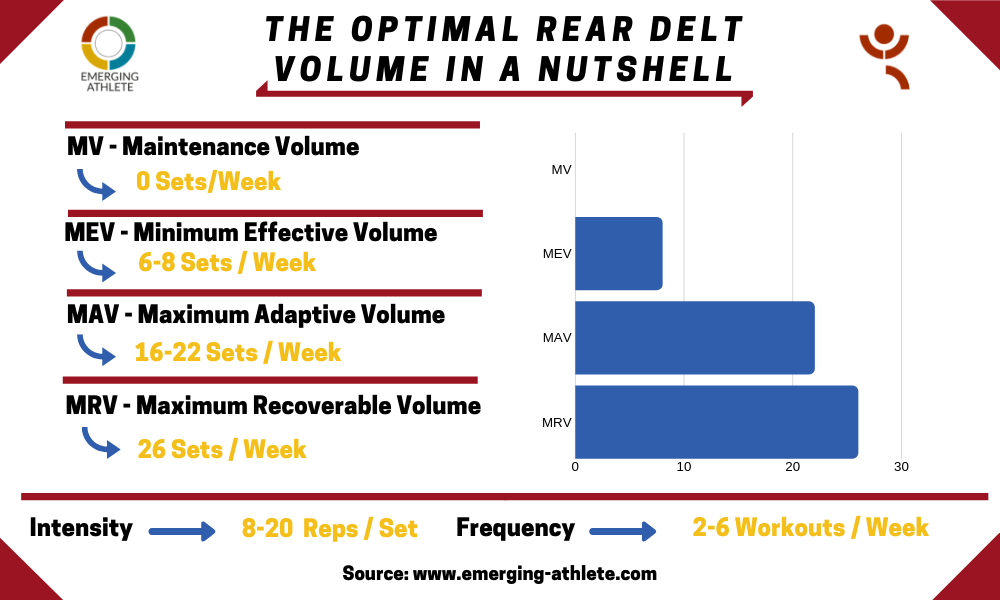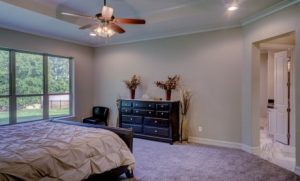Today we’ll complete the shoulder volume series.
After we already covered the front and side delts, it’s time to take a closer look at the optimal rear delt volume.
While reading this article you probably notice that a lot of parameters look alike the values from the previous article about side delts.
Is this a coincidence? You probably guessed it, no, it’s not.
This is because a lot of exercises (e.g. Upright Rows) stimulate both side and rear delts. Both are small muscles of the shoulder and in general, the way how we approach and train them is very similar.

Therefore, I initially thought about putting both muscles into one guide, but eventually, I decided to split them up. Because from my point of view, this way it’s a more clear overview for you, guys.
Besides, there are still some small differences between them which could’ve come up too short in only one coherent guide.
If we take a look at the average shoulder training program, it is very likely to see that lots of people neglect their rear delts.
Most people start their workout with a heavy compound shoulder press, which indeed is a good thing to do, but the majority really miss exercises that stimulate their rear delts.
Instead of switching the focus to their backside, the usual follow up is side laterals. Nothing wrong about that but if you belong to that sort of guys with underdeveloped rear delts, you should overthink your approach to training.
You now might think, wait don’t you said that lateral side raises are a good exercise?
Indeed, I did and that’s true! The problem occurs after they finished their side delt workout.
I almost never saw someone who has weak or underdeveloped front delts. The opposite appears when looking at most people’s rear delts.
How is that possible? Does everybody have good front delt genetic predispositions?
Definitely not, this is as always very individually.
The point is way more logical. The front delts get involved in almost every push exercise to at least some extent.
Now, if we take a look at the average training program, we will probably see bench press, some kind of incline press and at least one shoulder/overhead press.
The point is that most people don’t understand that this workload is already sufficient to stimulate front delt growth… And eventually rear delts come off badly from that.
Thus, I highly recommend and advise you to pay more attention to your rear delts!
Most people don’t need any or only a small amount of additional front delt work.
If you’re not yet familiar with volume, what that actually is, how it affects our muscle growth and what you should know about it, check out our complete guide about the optimal volume for hypertrophy.
Alright, what can you expect from this article series about volume applied to each muscle?
Based on Dr. Mike Israetel’s knowledge and experience, as well as our own, we want to clarify which volume works best for each muscle.
MV – Maintenance Volume
Why is it important to know your MV?
This is important to know because if you have close in your workouts for some time, you don’t want to lose your hard acquired gains, do you?
Furthermore, after very demanding workouts in between your MAV and MRV or even above your MRV, it is for sure a good thing to lower your volume from time to time.
It might even be necessary. This helps to desensitise your body and set it up responsive for new stimuli in the next mesocycle
For that reason, it is crucial to know where your MV lies to ensure you don’t lose muscles as well as not exceeding appropriate volume in your “deload phase”.
What does the rear delt MV look like?
MV: 0 sets/week
How is it possible to maintain your rear delts with 0 sets/week?
Relatively simple and similar to what I just mentioned about front delts.
If you’re doing a lot of pulling exercises, in most cases you don’t need any further rear delt isolation work because the rear delts already get involved during almost every pulling exercise.
MEV – Minimum Effective Volume
Before we get closer and more in-depth to some benchmarks, I have to emphasize something important again.
Remember that for all these values, there is a huge range and they differ individually.
This also clarifies why it is nearly impossible to sell any training programme for multiple people.
Everybody has their own genetic predispositions, which is why an identic volume for different people can’t bring similar results.
What’s the point I want to make here?
Only with experimentation, tracking your progress and testing out different things, you find out what your optimal rear delt volume is and adjust it according to your current training program.
Why is it important to know your MEV?
As well as it is important to know how much volume your rear delts demand to keep its current size, it is at least of similar importance to know how much volume is needed to grow your rear delts.
Where is a good benchmark for the optimal rear delt MAV?
MEV: 6-8 sets/week
This is on average the minimum amount of work that most people need to stimulate some growth in their rear delts.
You can try to train them less, but actually, they’re super easy to exercise and don’t fatigue very fast.
Rear delts are also pretty fatigue resistant which means that you need a certain level of stress to reach them properly.
MAV – Maximum Adaptive Volume
Why is it important to know your MAV?
Let me ask you a counterquestion.
Do you want to train all the time with the least effective volume?
Nope, nobody wants to spend hours in the gym every week but still only seem some spare results.
In order to stimulate the best possible muscle growth, we need to put more effort into our workout and increase the volume consistently throughout the weeks.
For this reason, it is important to know where your MAV lies to maximize your muscle growth effect.
Which MAV volume is most likely to stimulate good growth?
MAV: 16-22 sets/week
As you can see, the rear delts can handle relatively high volumes. There are two main reasons for that
First, the rear delts are small muscles which recover fast and can respectively be trained more frequent.
Second, despite their small size, they’re pretty fatigue resistant. Accordingly, rear delts need some serious workload to grow.
MRV – Maximum Recoverable Volume
Sooner or later in your mesocycle programme, you’ll sophisticate a point where your performance might bring to stagnate or even decrease. This is an indication that you probably overreached your MRV.
What does that mean?
The MRV refers to the maximum volume from which our body can recover properly.
To put it in other words, the maximum amount of work that your body can sustain until your strength and performance might suffer since your body is not able to fully recover.
Why is it important to know your MRV?
Pretty obviously, nobody wants to take a forced break only because your own training program is made up of too much volume.
Therefore, it is very crucial to know where your MRV lies to keep your body recovered and avoid superfluous breaks.
In line with this, what is a volume that simulates proper muscle growth but still recoverable?
MRV: 26 sets/week
Why such a high volume for such small muscles?
Because these are muscles of the shoulder that don’t take super high damage from the remaining training due to their anatomical position.
They’re basically not stretched under load to an excessive amount. Also, using tonnes of weight is not recommended either since their anatomical construction does not favor that.
If you compare heavy compound exercises like deadlifts with rear delt exercises, it becomes pretty clear why you cannot nearly use as much weight.
These compound exercises involve a lot of different muscles and are really fatiguing for our body. According to that, you also need adequate recovery time.
But if we look at the rear delts, we mainly train them with reverse fly movements.
Movements like that don’t involve as many muscles as squats or deadlifts and therefore recover a lot faster.
This means you can increase the volume for rear delts because a) they don’t get involved that much through your training program and b) they recover faster from the taken damage.
Frequency
How frequent should I train for the optimal rear delt volume?
2-6 workouts/week
Regarding training frequency, rear delts behave similarly to biceps and side delts. They recover really fast and almost never get exposed to huge amounts of damage.
That’s why you can train them at least twice a week. A lot of people get good results from 3-4 workouts/week. Some folks can even handle 5-6 times/week.
What frequency works best for your body, your goals and current training level is almost impossible to generalize.
On that note, never use these recommendations as fixed benchmark values, always adapt them to your program and adjust things over time.
If you have issues growing your delts and your program is build up with a whole shoulder day, consider splitting it into separate delt workouts.
Because a) they recover really fast and b) according to that you can hit them more frequent.
Furthermore, if you train them separately your performance might also increase.
For example, if your current shoulder program looks like the following: 10 sets rear delts, 10 sets side delts and 6 sets front delts, it is probably a better idea to split it up into separate shoulder days.
As a consequence, you’re in charge of 100% of your energy prior to each training day. Your body will thank you later with improved performance during each shoulder workout.

Intensity
What about the intensity for the optimal rear delt volume?
8-20 reps/set
Smaller muscles often respond better to high than low rep ranges.
Besides that, I personally experienced really good growth in my side delts with relatively heavy side lateral raises (8-10 reps/set).
Does that mean you should do heavy side lateral raises as well?
No, of course not.
A lot of people have difficulties to properly feel their delts.
For those people, I would suggest experimenting with higher reps between 12-20. Mind muscle connection is always a good thing to pay attention to, especially when we’re talking about smaller muscles.
For folks who don’t have any issues with that, you can definitely go heavier and down up to 8 reps/set.
Variation is key and only by that, you get an impression of what works for you.
Any less than 8 reps is probably too heavy and mainly endangering for your shoulder joints and elbows.
With this in mind, I recommend you to try out different rep ranges between 8-20 and choose the one that suits you best.
Rear Delt Workout – Exercises
This wouldn’t be a complete Emerging-Athlete guide without a closer look at the actual workout.
In the following, I’ll list you common and effective exercise for the optimal rear delt volume.
Basically, the major movement when exercising rear delts is bringing our arms behind the back. This can be accomplished through reverse fly or pulling movements.
Rear Delt Exercises:
- Reverse Flys
- Butterfly Reverse
- Bent over Reverse Flys
- Supine rowing
You can do most of these exercises either with dumbbells, a cable or even using machines.
If we refer back to what I’ve said earlier, the same will be true here.
The more pulling exercises you do, the less rear delt isolation you’ll need to do.
This is important because the abovementioned exercises are sole of isolating nature.
I excluded normal pulling exercises (e.g. rows, pull-ups) because they build up your foundation on top of which you add certain isolation movements.
Eventually, do some experimentation and track your progress. Adapt your rear delt volume to your current back/pull volume gradually.
Range of Motion
As you probably already anticipated from all other volume guides, range of motion is and will always be a big deal!
Doesn’t matter if it’s about big muscles, small muscles, isolation or compound exercises.
You should never sacrifice a proper range of motion for heavier weights that you need to swing around as you can’t control them properly.
There is nothing particularly special about rear delts here, more or less the same important facts about range of motion. But I can’t emphasize it too often.
What’s the point in wasting muscle growth potential while simultaneously increasing your own risk to injuries?
If you take something through a full range of motion safely it almost always comes along with the most growth.
This is because stretch under load is a big hypertrophy factor.
Furthermore, when you’re doing a full range of motion you activate as many muscle fibres as possible. And logically, the more activated muscle fibers, the more muscle growth.
Conclusion
Let’s review what’ve talked about and summarize what you should keep in mind for the optimal rear delt volume.

Exercises: The major movement when exercising rear delts is bringing your arm behind the back (reverse flys or any rowing). All the pulling exercises from your current program serve as a foundation on top of which you add some isolation exercises.
Range of Motion: Never sacrifice a proper range of motion for heavier weights!
Eventually, you can’t control them properly which only endangers your own health. Furthermore, you even waste muscle growth potential because a full range of motion activates even more muscles fibres.
Practical Tips
As always, to round off this article about the optimal rear delt volume, I’ll present you a couple of methods and techniques that work quite well for the rear delts.
They all have already been mentioned in previous volume articles which is why I am not going into such detail here anymore.
If you’re new and don’t have a clue what I am talking about here, just check out one of our previous volume articles.
Super sets: Combines a heavier compound exercise + isolation exercise (e.g. Upright Rows + Reverse Flys)
For more detailed information, click the highlighted link to read a separate article that I wrote about supersets.
Drop sets: Start with a certain weight and stop close before failure. Then you reduce the weight (e.g. about 25%) and stop again close before failure. You can do this as long as you want.
The same applies for drop sets, click the link for more in-depth information.
Giant sets: Set yourself a certain rep number that you want to accomplish (e.g. 100 reps) and do as many sets as you need to reach this number.
Special shout-out to Dr. Mike Israetel, we really value his knowledge and the content that he shares with you guys on his YT channel and his blog.
Definitely check out his video about side delt volume!
How often do you train your rear delts?
Share your experiences with us in the comments below!
As always, if this article was helpful, we would appreciate if you share it with your friends and family.
I hope this article about the optimal rear delt volume answered all your questions.
If you still have further questions or feedback, just leave a comment below or check out our social media channels!
Cheers guys,
Claas




